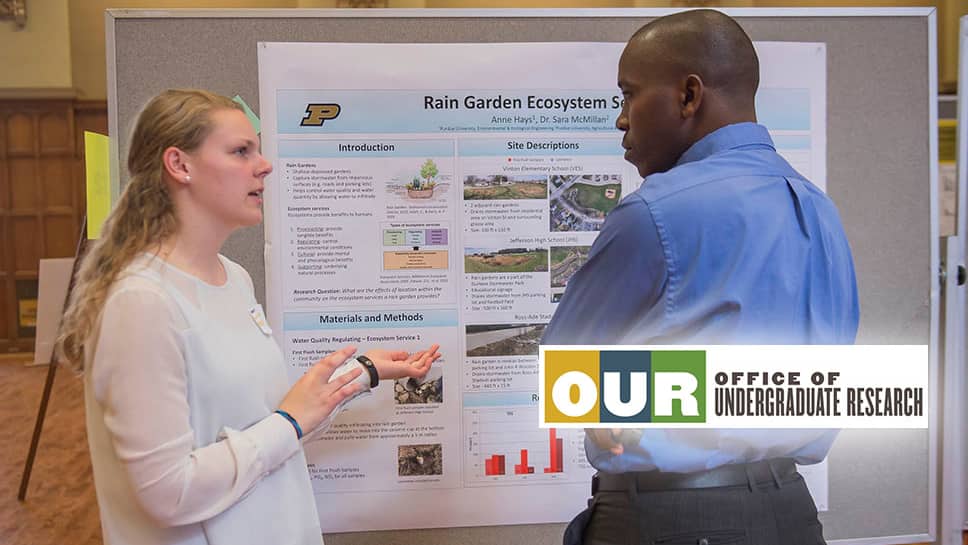
Several Purdue Polytechnic students were recognized by Purdue’s Office of Undergraduate Research (OUR) for their spring projects.
Nicole Dwenger won first place among Polytechnic entries for her poster at OUR’s 2020 Spring Undergraduate Research Conference, a judged event highlighting students’ scholarly work and creative endeavors. Qingyuan Hu and Yi Zhang won second place, and Sarah Wolfe won third place.
For Dwenger’s research, entitled “Survey Research Instrument for the Data Visualization Process,” she worked to enable web-based access to digital instruments that catalog data visualization projects. Vetria Byrd, assistant professor of computer graphics technology, served as her research mentor.
Hu and Zhang analyzed how computational models predict the relation between sentences that describe a premise versus sentences that describe a hypothesis in natural language. They focused on hypothesis-only models for word-level patterns to reveal potential lexical biases that could contribute to the models’ performance. Their poster was titled “Exploring Lexical Irregularities in Hypothesis-Only Models of Natural Language Inference.” Their research mentors were Kanishka Misra, a graduate teaching assistant, and Julia Rayz, associate professor of computer and information technology.
Wolfe collected and analyzed data from professional flight students to determine pilots’ level of sleepiness at daily measured times. Her goal was to identify both days of the week and specific times of the day in which pilots are most fatigued. Wolfe’s research mentor was Julius Keller, assistant professor of aviation technology.
Additional Polytechnic undergraduate research projects
Several other Polytechnic students presented posters or oral presentations at OUR’s Spring Undergraduate Research Conference. The following were among the Polytechnic students who participated in the conference:
- Curtis Bouchie, “Ground Support Equipment Damage Mitigation:” Bouchie collaborated with Nathan Smith, a College of Engineering student, to integrate an infrared range-finding system with a readily available belt loader. Their goal was to demonstrate that airports’ older ground support equipment used near aircraft can be retrofitted with collision avoidance technology.
- Cassandra Foster, “Determining Resonant Frequency in Varying Guitar Bodies:” Foster used a rigid testing structure to experiment with the Helmholtz resonator model, a mathematical model for predicting how a guitar’s sound hole size and body volume affect its resonant frequency.
- Vick Hung, “Enhancing Conveniences beyond Remote Control through an Ontology-based Internet of ‘Kitchen Things:’” Hung collaborated with Haozhe Zhou (College of Science) and Qinglan Wu (College of Engineering) to improve complex multi-step activities such as cooking, integrating ontological semantics to dispatch tasks to Internet of Things appliances.
- Alia Kabba, “Promoting Diversity In STEM: Creating a more inclusive campus for underrepresented minorities in STEM spaces at Purdue University:” Kabba examined high-impact programs and their role in enhancing recruitment and retention of diverse populations in science, technology, engineering and math fields at Purdue.
- Natalie McGuckin, “Dynamic Visualization in Game Theory:” McGuckin conducted research related to a foundational game theory problem that has been open since the 1960s. She collaborated with faculty and colleagues from five universities to analyze the results of 72 petabytes of data from 37 years of computation on Purdue computing clusters, designing a visualization to improve understanding of the underlying structure of the mathematics for the game theory problem.
- Varun Ramakrishnan, “Virtual Reality Environment Optimization based on Real Environment Constraints:” Ramakrishnan collaborated with Krishna Suresh, a student in the College of Science, to present a novel method for real and virtual constraint-based level generation for 3D games, and virtual simulations where the user’s physical space does not match with the game’s virtual space.
- Alex Small, “A Study of the Human Factors Analysis and Classification System (HFACS) as Applied to Asiana Airlines Flight 214:” Small utilized the HFACS framework to isolate the human factors that contributed to a 2013 Asiana Airlines accident.
- Jason Su, “Effects of Avatar Heights in Work and Learning Abstract:” Su studied how size discrepancies between avatars in virtual environments influences users.
- Abagail Westbrook, “If They Build It, Will They Come? Disconnected Resources at the Northend Community Center:” Westbrook performed qualitative research, including ethnographic engagement, interviews and workshops, to study expectations of people who facilitate community centers and engagement of people for whom such centers are designed.
- Casey Vargovcik, “Augmented Reality app for Pilots of Unmanned Aerial Systems:” Vargovcik researched the development of an augmented reality app to allow pilots of unmanned aerial systems to locate and visualized manned aircraft operating in the same airspace to prevent potential collisions.
- Yi Zhang, “A Sequence Model Based Approach to Unknown Words Identification:” Zhang explored the feasibility of including semantic features into contextualized-based machine learning models for resolving unknown words during natural language processing.
- Allen Zheng, “Understanding the Complex Canvas of Lafayette Using Data Visualization:” Zheng applied data visualization techniques to understand census data for Indiana and Lafayette, utilizing visualization layouts that provide insights into the socioeconomic indicators that exist in the data. Zheng created a dashboard to visually represent the data and help identify issues related to poverty and inequitable distribution of resources.
See OUR’s list of conference abstracts for a complete listing of students who participated.
Additional information
- Office of Undergraduate Research
- Award recipients from Undergraduate Research Conferences, 2014-present (Office of Undergraduate Research)
- Spring conference abstracts, 2014-present (Office of Undergraduate Research)
